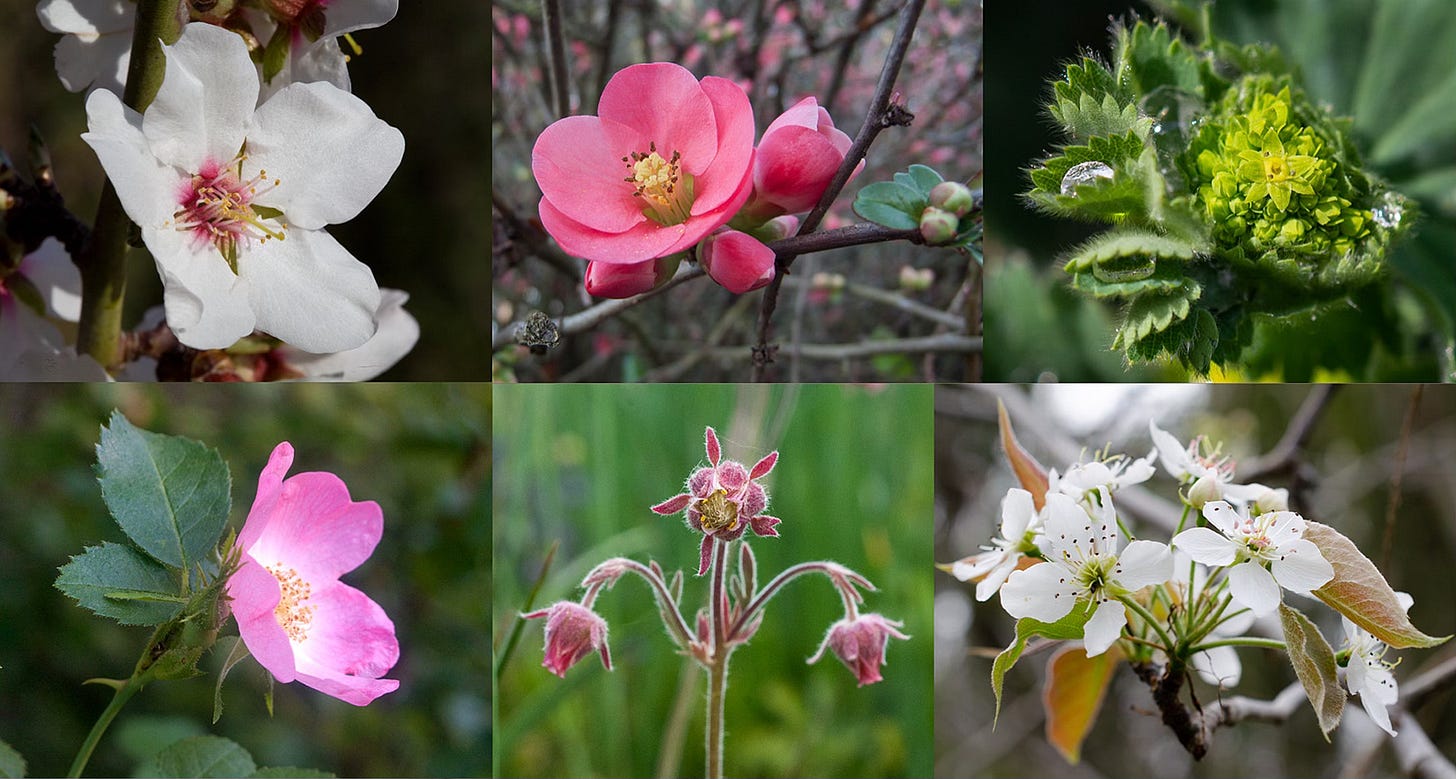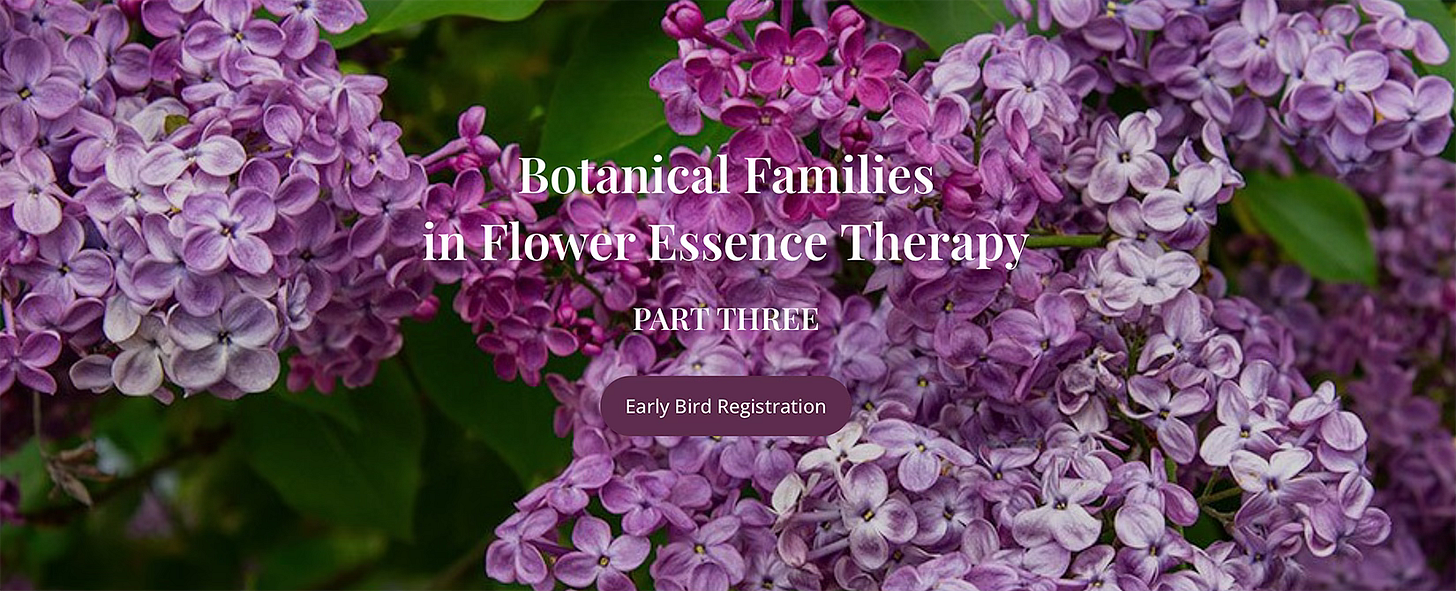Patterns that run in Plant Families
[Plant Archetypes] Traits that repeatedly appear in related plants inform our Soul and Essence work
The greatest breakthrough I’ve experienced in my education as a Flower Essence Practitioner happened when I was inspired to attentively learn to see archetypal gestures in each plant from which an essence is prepared. And there was more!
Plant observation brought it all to life!
How potent these first lessons in the gardens have been!
In an upcoming post I will share more about this vitalizing path of learning that primed me when I took my very first training at FES. But today I want to write about what I was learning there, in parallel, in the evening lectures of my FES training at Terra Flora in 1991, with my mentors Richard Katz and Patricia Kaminski.
Patricia and Richard have pioneered a very special way of studying flower essence plants (and their essence qualities) through the perspective of the 12 Windows of Plant Perception, with a highlight on the study of their Botanical Families.
This requires us to keenly observe individual Plants in full detail, with a beginner’s mind. And from there, by perceiving common patterns appearing in related plants, we begin seeing signature patterns running through whole botanical plant families!
From bulb, to first sprout, to moist gentle flowers
Hearing and seeing images, and creating an internalized perception of these sequences of gestures such as: the bulb, the ascending sprout, the bud, the gentle and moist flower, initiated me into the adventure of reading plant gestures.

As we continued, I was shown an overall view of patterns that would repeatedly appear, in similar but not identical ways, in other related plants.
I could now see correlating traits expressed in a whole botanical family!

The above essence plants, now classified as belonging to the Asparagaceae botanical family, are all monocotyledons, sprouting from small bulbs barely rooted on the earth. Monocotyledon plants first sprout with only one leaf emerging from a rounded bulb, that may contain great part of the nutrients needed for their growth and flourishing.
The above flowers all have six tender petals, in clear geometric arrangement.
Feminine gentleness, caring and receptive qualities are expressed through all of these plants, while each individual species, in its uniqueness, brings to the world distinct Archetypal qualities of their own.
As you read my summary of descriptions of their essence qualities, you can feel what unites them all, while seeing the unique qualities that each one conveys.
Star of Bethelhem Ornithogalum umbellatum - (blooms again in the same location every year in late Spring, opening only when there is bright sun, while otherwise green striped buds stay closed) soothes and helps restore a sense of inner divinity and wholeness, when one may have experienced shock and trauma, recent or in the past.
Pretty Face Triteleia ixioides - (grows wild in high altitudes of the Sierra Nevada) a sense of radiant and luminous inner beauty, when one feels ugly and/or tainted, due to appearance, demeaning inner self image, racial heritage or family status.
Glassy Hyacinth Triteleia lilacina - (grows on volcanic soil and lava fields, flowering with iridescent luminosity in early Spring, around Easter) when one’s life has involved the descent into dark passages involving profound sorrow, pain and/or humiliation, and the time has come to resurrect, rising up to the light; supports full redemption with understanding of one’s soul initiation.
A range of Calochortus species native in California
The flowers below are all related, in more than one way. They are all part of the Liliaceae botanical family, but they are even more closely related, being all in the Calochortus species. They share very specific similarities, some that you can observe at first glance, like the hairs at the center, while expressing distinct differences in where they grow and how they have adapted to their unique environments.

While the Mariposa Lily Calochortus leichtlinii blossoms high up on the Sierra Nevada (read about it in this post called A Feminine and Nurturing Plant Archetype) the Star Tulip Calochortus tolmiei blooms right by the Pacific ocean (read more about it in this post. The Yellow Star Tulip Calochortus monophyllus blooms at mid elevations, at the foothills of the Sierra (also mentioned in the post linked above), and the Fairy Lantern grows in the same foothills areas and also at lower elevations.
Each one has specific flower essence qualities, with some traits that connect them, bringing in a gentle quality of evolutionary movement.
A line of research that sparked a continuing curiosity
From those days onwards I was totally captivated by this perspective. I remember going back to Brazil keenly motivated, looking into all the books I had access to, encyclopedias of plants of every kind I could get hold of, to discover more and more about these relationships and common patterns.

Discoveries revealed through Family Trees
For me, this kind of curiosity has a history that goes far back. In high school, genetics quickly became my favorite subject, and as an adult, I love engaging in the illuminating discoveries revealed by the research of our family trees.
I have taken no less than three DNA tests, offered by different companies, to discover more about my ancestry. And, needless to say, Finding your Roots, created by Henry Louis Gates Jr. is one of my very favorite filmed series ever.
Raised in a family of scientists and artists
If you have been following this Blog, you know by now that my first career was as a photographer. But in that story, I did not share that my first darkroom was a reconversion of my grandmother’s anatomy-pathology lab, in which she prepared glass plates of finely cut tissue that my grandfather would examine in the microscope to diagnose cell malignancy.
My grandmother also made detailed drawings of microscope views of cells using fine watercolor pens, to illustrate my grandfather’s academic studies and books.
When they closed that part of their work and retired, I inherited the use of this little room with running water, where I set up my photo lab to begin developing film and making black and white prints.

Fascinated by the evolutionary history of plants
In our flower essence work, what we relate to in our studies is the living uniqueness of each plant, as it exists in the living world. The living plant is the source we always want to go to, and what is really important for us.
However, being someone so interested in genetics, I also love to investigate a specific plant by seeing its placement in the greater Family Tree of plant species. This evolutionary tree has been redrawn in the last decades to include findings that came from DNA studies. I have these printed posters in my bathroom and in my office.
Our Botanical Families series of Flower Essence Courses
You can see why I am so passionate about this series of courses that Kathleen Aspenns and I have been co-creating and co-teaching.
We have two previous iterations available for self study, and they all include Bach, FES California, Alaskan Essences, Bush Essences, Living Essences and Flora of Asia within the scope of each featured botanical family.
With gratitude to the pioneers of these studies Richard Katz and Patricia Kaminski, we are now launching the third iteration of this series, that opens up with a cherished Flora of Asia essence plant, the Katsura tree.
In this course, featuring around 15 groups of essence plants organized by families, we will talk about how Olive, Jasmine, Lilac and Forsythia are related through their Oleaceae family, and so much more.






So wish I could take this course this time. Too many other wonderful things b on my plate at the moment.
So beautifully shared, seeing through the lens of flower family relationships in the FES practitioner course with you has been been so supportive to this journey. 🌸🙏🏼